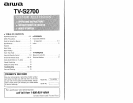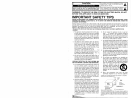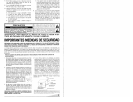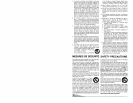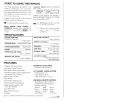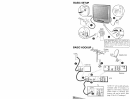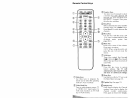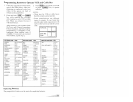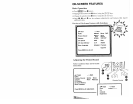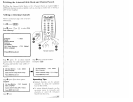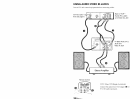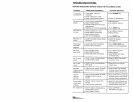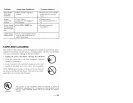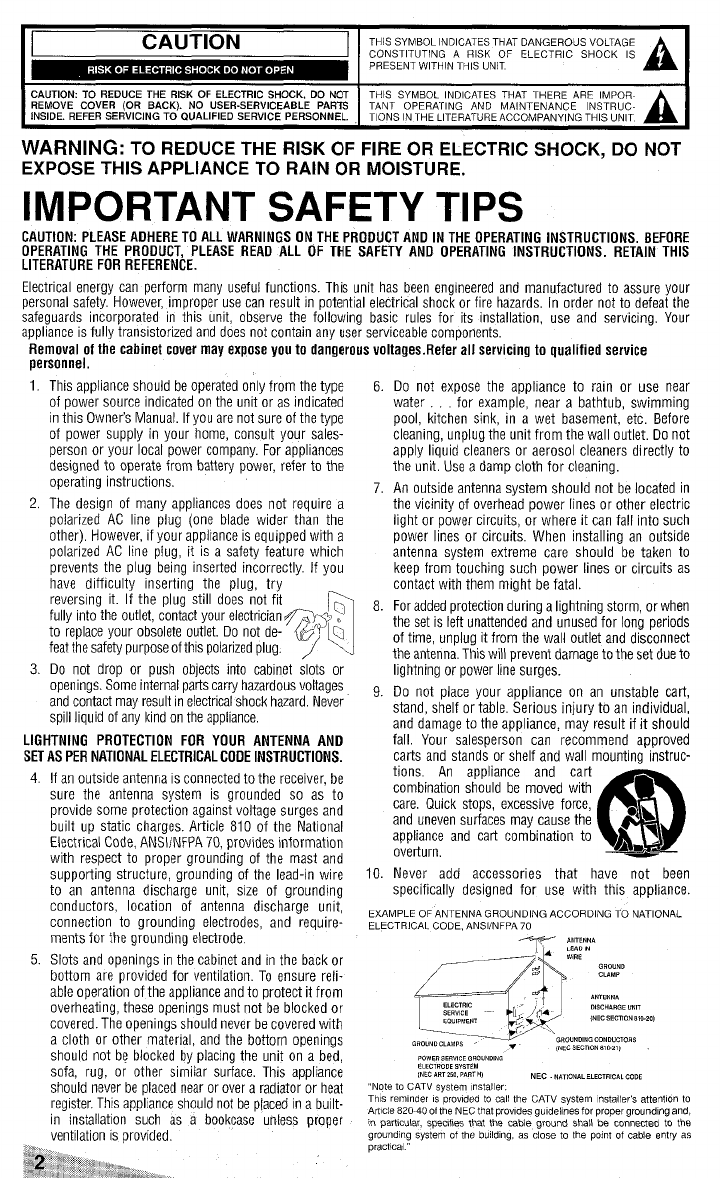
CAUTION
THIS SYMBOL INDICATES THAT DANGEROUS VOLTAGE
CONSTITUTING A RISK OF ELECTRIC SHOCK IS
PRESENT WITHIN THIS UNIT
A
CAUTION: TO REDUCE THE RISK OF ELECTRIC SHOCK, DO NOT
THIS SYMBOL INOICATES THAT THERE ARE IMPOR.
REMOVE COVER (OR BACK). NO USER.SERVICEABLE PARTS
TANT OPERATING AND MAINTENANCE lNSTRUC-
fNSIDE. REFER SERVICING TO QUALIFIED SERVICE PERSONNEL.
TIONS IN THE LITERATURE ACCOMPANYING THIS UNIT
A
WARNING: TO REDUCE THE RISK OF FIRE OR ELECTRIC SHOCK, DO NOT
EXPOSE THIS APPLIANCE TO RAIN OR MOISTURE.
IMPORTANT SAFETY TIPS
CAUTION: PLEASE ADHERE TO ALL WARNINGS ON THE PROOUCT ANO IN THE OPERATING INSTRUCTIONS, BEFORE
OPERATING THE PROOUCT, PLEASE REAO ALL OF THE SAFETY ANO OPERATING INSTRUCTIONS. RETAIN THIS
LITERATURE FOR REFERENCE.
Electrical energy can perform many useful functions. This unit has been engineered and manufactured to assure your
personal safety. However, improper use can result in potential electrical shock or fire hazards. in order not to defeat the
safeguards incorporated in this unit, observe the following basic rules for its installation, use and servicing. Your
appliance is fully transistorized and does not contain any user serviceable components.
Removal of the cabinet cover may expose you to dangerous voltages. Refer all servicing to qualified service
oersonnel.
1.
2,
3.
This appliance should be operated only from the type
of power source indicated on the unit or as indicated
in this Owner’s Manual. If you are not sure of the type
of power supply in your home, consult your sales-
person or your local power company. For appliances
designed to operate from battery power, refer to the
operating instructions.
The design of many appliances does not require a
polarized AC line plug (one blade wider than the
other). However, if your appllance is equipped with a
polatized AC line plug, it is a safety feature which
prevents the plug being inserted incorrectly. If you
have difficulty inserting the plug, try
reversing it. If the plug still does not fit
fully into the outlet, contact your electrician
&y
to replace your obsolete outlet. Do not de- & Q
feat the safety purpose of this polarized plug. / .
Do not drop or push objects into cabinet slots or
open ings. Some internal parts carry hazardous voltages
and contact may result m electrical shock hazard. Never
spill liquid of any hnd on the appliance.
LIGHTNING PROTECTION FOR YOUR ANTENNA AND
SET AS PER NATIONAL ELECTRICAL COOE INSTRUCTIONS.
4. If an outside antenna
IS connected to the receiver, be
sure the antenna system is grounded so as to
provide some protection against voltage surges and
built up static charges. Article 810 of the National
Electrical Code, ANS1/NFPA 70, provides information
with respect to proper grounding of the mast and
supporting structure, grounding of the lead-in wire
to an antenna discharge unit, size of grounding
conductors, location of antenna discharge unit,
connection to grounding electrodes, and require-
ments for the grounding electrode,
5. Slots and openings in the cabinet and in the back or
bottom are provided for ventilation. To ensure reli-
able operation of the appliance and to protect it from
overheating, these openings must not be blocked or
covered. The openings should never be covered with
a cloth or other material, and the bottom openings
should not be blocked by placing the unit on a bed,
sofa, rug, or other similar surface. This appliance
should never be placed near or over a radiator or heat
register. This appliance should not be placed in a built.
in installation such as a bookcase unless proper
ventilation is Drovided.
6
7
8
9
to
Do not exoose the a~oliance to rain or use near
water ‘for examp(e~ near a bathtub, swimming
pool, kitchen sink, in a wet basement, etc. Before
cleaning, unplug the unit from the wall outlet. Do not
apply liquid cleaners or aerosol cleaners directly to
the unit. Use a damp cloth for cleaning.
An outside antenna system should not be located in
the vicinity of overhead power lines or other electric
light or power circuits, or where it can fall into such
power lines or circuits. When installing an outside
antenna system extreme care should be taken to
keep from touching such power lines or circuits as
contact with them might be fatal,
For added protection during a lightning storm, or when
the set is left unattended and unused for long pefiods
of time, unplug it from the wall outlet and disconnect
the antenna, This will prevent damage to the set due to
lightning or power line surges.
Oo not place your appliance on an unstable cart,
stand, shelf or table. Serious injury to an individual,
and damage to the appliance, may result if it should
fall. Your salesperson can recommend approved
carts and stands or shelf and wall mounting instruc-
tions, An appliance and cart
combination should be moved with
care, Quick stops, excessive force,
and uneven surfaces may cause the
appliance and cart combination to
overturn.
(!!!!
A&
Never add accessories that have not been
specifically designed for use with this appliance.
EXAMPLE OF ANTENNA GROUNDING ACCORDING TO NATIONAL
ELECTRICAL CODE. ANS1/NFPA 70
..,”,,.,
-- @
0,s,”,,,, “m
I./v
W. SECTION810-201
>.
\
=~ * ‘ROu”O’NG -cro’$
{WC Smno. *30.? ,
,O.,,,,,”,,,,,O ”,,,,,
a,,,..,, SYSTEM
[N,, ,,,
,s0,,,,, H,
NEC .,,,,0..,,,,.,,,,,,,,0,
,Note to CATV system Installer.
Th,s mnndw ,s mo,,ded to call the CATV s“stem m,talle,,s Wten!lon to
AM. 82040 of the NEC that prrwdes gudelks for proper gro”.d!ng and,
m parfwlar, spe’afms that the cable ground shall be connected to the
gro.ndmg system of the bulld(ng, as close to the potnt of cable entry as
practl.al,



